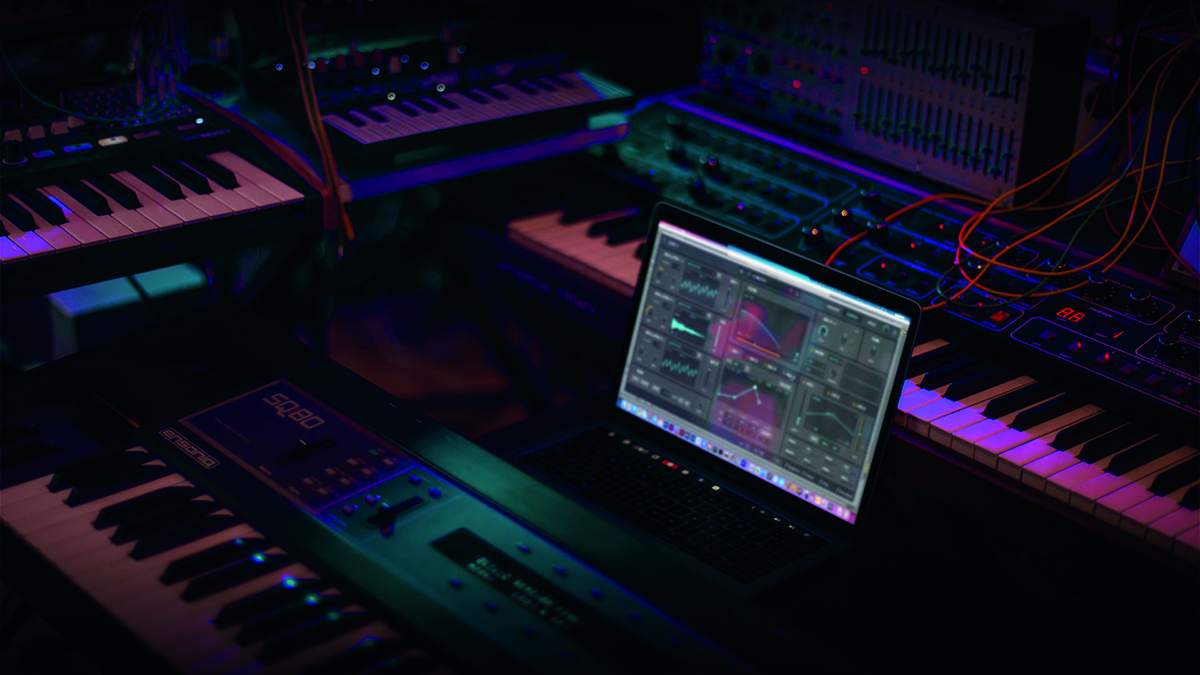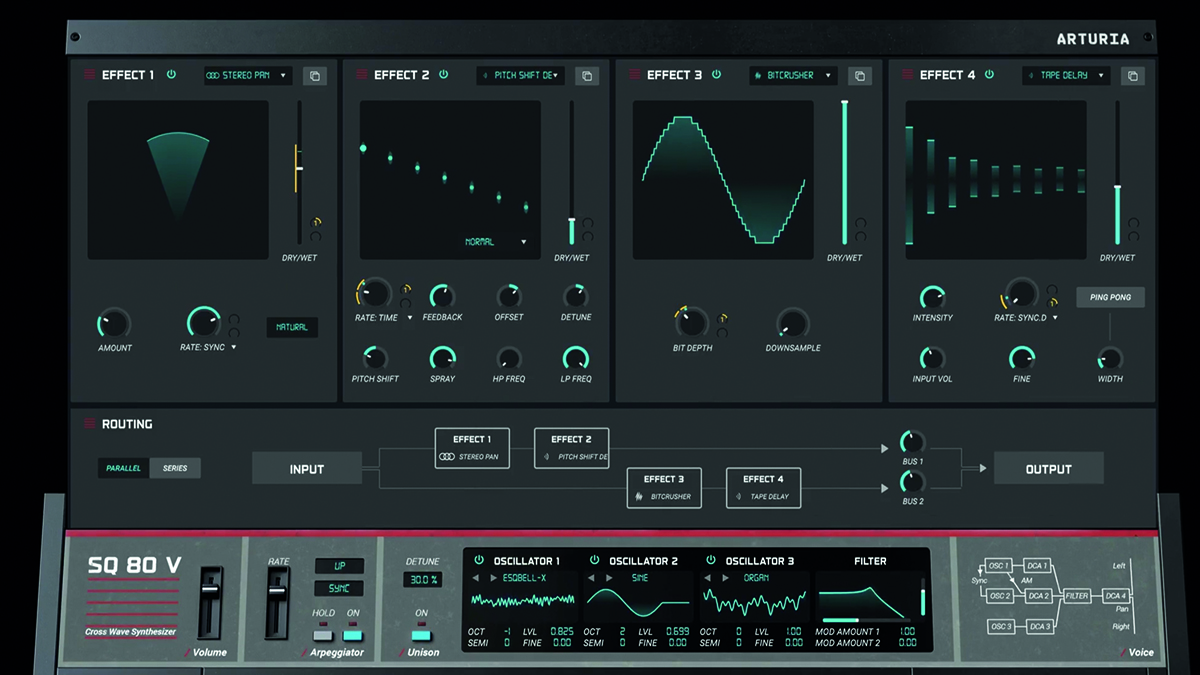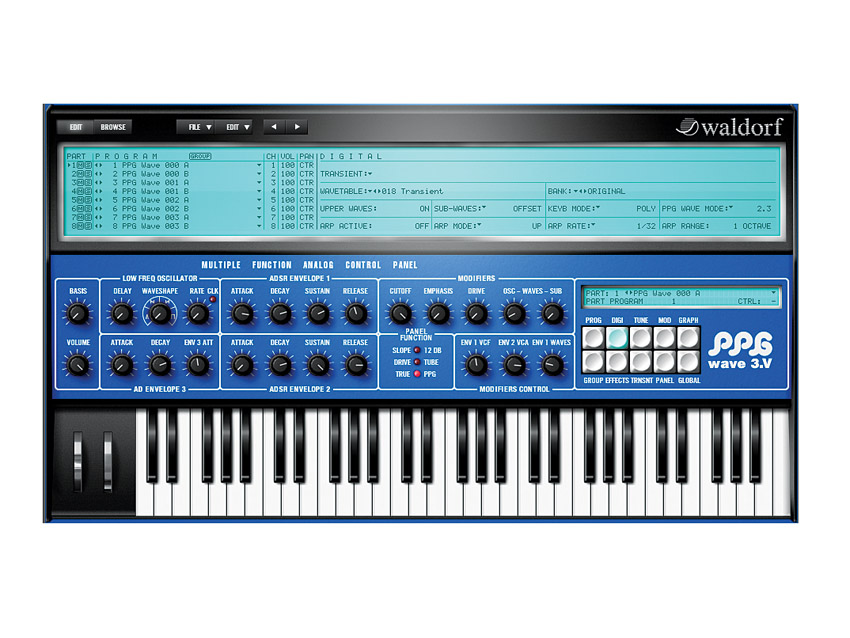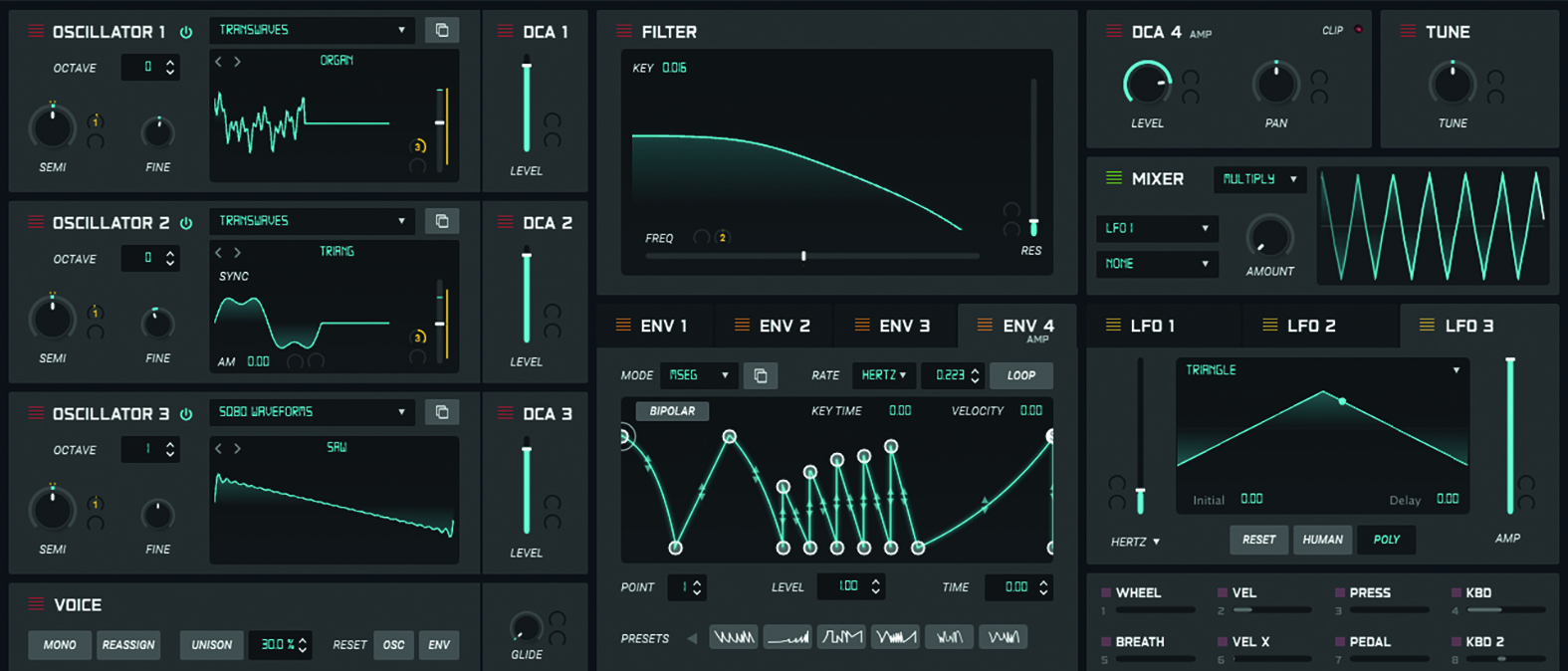MusicRadar Verdict
As a gritty, early digital synth with attack and vigour, the SQ80 V is a stylised classic with some nice hidden depths.
Pros
- +
The visual SQ aspect is excellent.
- +
Sounds suitably stylised, with room for contemporary consumption.
- +
Extended modulation options, for movement and colour.
Cons
- -
An early digital sound-stamp.
- -
Modulation dials on the editor are small.
MusicRadar's got your back
Arturia SQ80 V: What is it?
During the 80s, sampling technology was becoming an indispensable part of music production. The only problem was, all the really elaborate samplers came with a caveat; did you buy a Fairlight CMI, or did you buy a house? For us mere mortals, this was an easy sell – after all, a Fairlight wasn’t great at keeping the rain off your head while you slept. But as sampling tech matured, so did the prices, thanks in part to the likes of E-mu, Akai and the fledgling Ensoniq.
In 1985, this new company entered the sampling age with a debut release. The Ensoniq Mirage was a vaguely affordable sampling keyboard, produced by some of the team that had brought the infamous Commodore 64 home computer to the market. By the time the SQ80 synthesiser arrived, music was chiming to the tones of digital synths. The Yamaha DX7 and Roland D-50 were established favourites, but the SQ80 offered something slightly different, armed with its own floppy disk drive and an elegant editing and menu hierarchy.
Billed as a Cross Wave Synthesiser, Arturia has worked their magic on this lesser-seen classic, which now acquires the inevitable ‘V’ after the SQ80. Their concept provides all the original qualities of this early digital machine, but with inevitable elements of new-spin. The SQ80 V capitalises on Arturia’s patented TAE (True Analog Emulation) technology, even though the SQ80 oscillators are pure digital and only 8-bit to boot. However, the original SQ80 filter was Curtis chip based, which is where the TAE porting to a digital domain will win through.

Arturia SQ80 V: Performance and verdict
Upon installation and load up, the first thing that strikes you about the SQ80 is that it is very stylised. As you meander through the pre-prepared patches, there’s a plentiful mix of nostalgia and forward thinking.
Some patches are undeniably kitsch; CLIOPE is distinctly based around one of the overused Roland patches from that era, and it’s unlikely to win any new fans; too many memories! But move away from the clichés and while many of the sounds are reminiscent of a bygone age, they feel relevant, and with further processing, can definitely live again.
The basic Piano patch, which has strangely been assigned to the Electric Piano category, presents a filtering grain at the front of each attack, which probably accounts for its Electric Piano status. It’s got that wonderful is-it-or-isn’t-it-real quality, which will sound great in numerous commercial settings.
Move over into the Pad and Sequence categories and you’ll begin to hear the areas where the SQ has been extended. Pulsing, angsty modern tones are mandated here, with arpeggiation and sharpened backend effects. Even at the basic GUI user interface level, animated waveforms gyrate in time with their modulated routing.

Arps and FX
We always applaud Arturia for coming up with a unique take on an old classic, and arguably the SQ80 needs more help than most to bring it kicking into the modern age. The modulation routings are comprehensive with this synth, albeit via the use of some relatively small ‘amount’ dials, but the two elements which bring something old but fresh to the SQ are the arpeggiator and the effects.
We applaud Arturia for a unique take on an old classic, and the SQ80 needs more help than most to bring it kicking into the modern age
The original SQ did boast a multi-mode sequencer, but by replacing the data entry fader with an arpeggiator section, Arturia has brought an immediacy to its consumption. Seven Arpeggiator patterns are available over the space of four octaves, coupled with sync’ing and latch modes, so you can get lost in those digitised waves for hours.
The addition of a very flexible effects section, on the backend of the signal chain, allows the selection of one of 16 different effects, in up to four instances. All of the usual suspects are here, along with notable appearances from the likes of the much applauded Juno Chorus. Pop that onto your pad, and soon you’ll be finding yourself with another brand of facsimile, through the basic requirement of a few sawtooths up front.
Going deep
The SQ80 V has three main display sectors; the Hardware display gives a clone-like image of the original, while the Synthesis and Effects displays are where the edited magic happens.
Entering Synthesis mode provides a clear representation of the signal path, beginning with three oscillators. In typical Arturia V style, all the original SQ80 digital waveforms are represented, with everything from basic Saws and Squares to more elaborate and descriptive samples of acoustic instruments. Being 8-bit in definition, many of these can sound a little crusty, but herein lies the charm of the synth, although this is far more noticeable with the complicated and acoustic samples.
Apart from the basic SQ80 waveform set, there is an extensive collection of further waveforms, described by Arturia as Hidden Waveforms, drawn from both the SQ80 and its predecessor, the ESQ1. These can feel very digitised and less useable on their own, but do offer plenty of colour to blend in with the other two oscillators, if supplying more mainstream sounds.

• Waldorf PPG Wave 3.V
Waldorf’s homage to the original wavetable machine, the PPG Wave.
• Native Instruments FM8
Based on the DX7, the FM8 takes the Yamaha FM concept to greater heights, with similarly stylised sounds and timbres.
A fourth waveform menu is described as Transwaves; these are morphable, shape-shifting waves that can immediately be controlled by modulation sources, such as LFO. This modulation can be applied at source, for ease of working.
Each oscillator accesses its own volume control, described in true 80s style as a DCA. This in turn feeds the resonant filter, modelled on the CEM3379 Curtis chip design. Arguably, this is the element that provides the SQ80 V with its charm and character, although the influence of the oscillators is undeniable.
Multiple modulation sources can help create movement for amplitude, filter and wave shaping; four envelopes provide the more usual amplitude control, with further tricks available from their menus. Apart from modelled SQ80 envelopes, which are switchable between linear and exponential shapes, MSEG and DADSR envelopes are also available. The MSEG envelope offers considerable freedom to shape, in both timing and level, with a clutch of relatively complex presets for immediate use.
The crossover between envelopes and LFOs is substantial, but if you’d rather use a common-or-garden LFO, there are also three available, with six waveforms attached to each.
To the SQ and beyond
Arturia’s decision to model this Ensoniq retro-classic is interesting. In line with certain other early digital synths and samplers, the SQ80 V supplies an innate sense of late 80s and early 90s character. We’d point out that by giving the SQ the Arturia treatment, it’s made this time-stamped classic feel far more commercially viable than it might have been as a straight clone. The modulation options for waveform and filter control, coupled with niceties like four-layer backend effects, convince us that the inadequacies of the original synth may be catapulted to the current age, or simply auditioned with affection. A very characterful synth, with commercial grunt and nostalgia.
MusicRadar verdict: As a gritty, early digital synth with attack and vigour, the SQ80 V is a stylised classic with some nice hidden depths.
Arturia SQ80 V: The web says
"The SQ-80 V does an excellent job of emulating the original SQ-80, and also offers enough new and worthwhile features to make this an exciting plug-in in its own right."
MusicTech
Arturia SQ80 V: Hands-on demos
Arturia
Jef Gibbons
Starsky Carr
Sonicstate
Arturia SQ80 V: Specifications
- Mac: 10.13+: 4 GB RAM; 2.5 GHz CPU.
- Windows: 8.1+ (64bit) PC: 4 GB RAM; 2.5 GHz CPU.
- 2GB free hard disk space
- OpenGL 2.0 compatible GPU.
- Works in Standalone, VST, AAX, Audio Unit.
- CONTACT: Arturia
Computer Music magazine is the world’s best selling publication dedicated solely to making great music with your Mac or PC computer. Each issue it brings its lucky readers the best in cutting-edge tutorials, need-to-know, expert software reviews and even all the tools you actually need to make great music today, courtesy of our legendary CM Plugin Suite.
Baby Audio's Smooth Operator spectral balancing plugin goes pro
"It was ugly, like watching a divorce between four people. After a while, I had to get out": Beatles engineer Geoff Emerick on the recording of Abbey Road, track-by-track
"I said, “What’s that?” and they said, “It’s what Quincy Jones and Bruce Swedien use on all the Michael Jackson records": Steve Levine reminisces on 50 years in the industry and where it’s heading next











